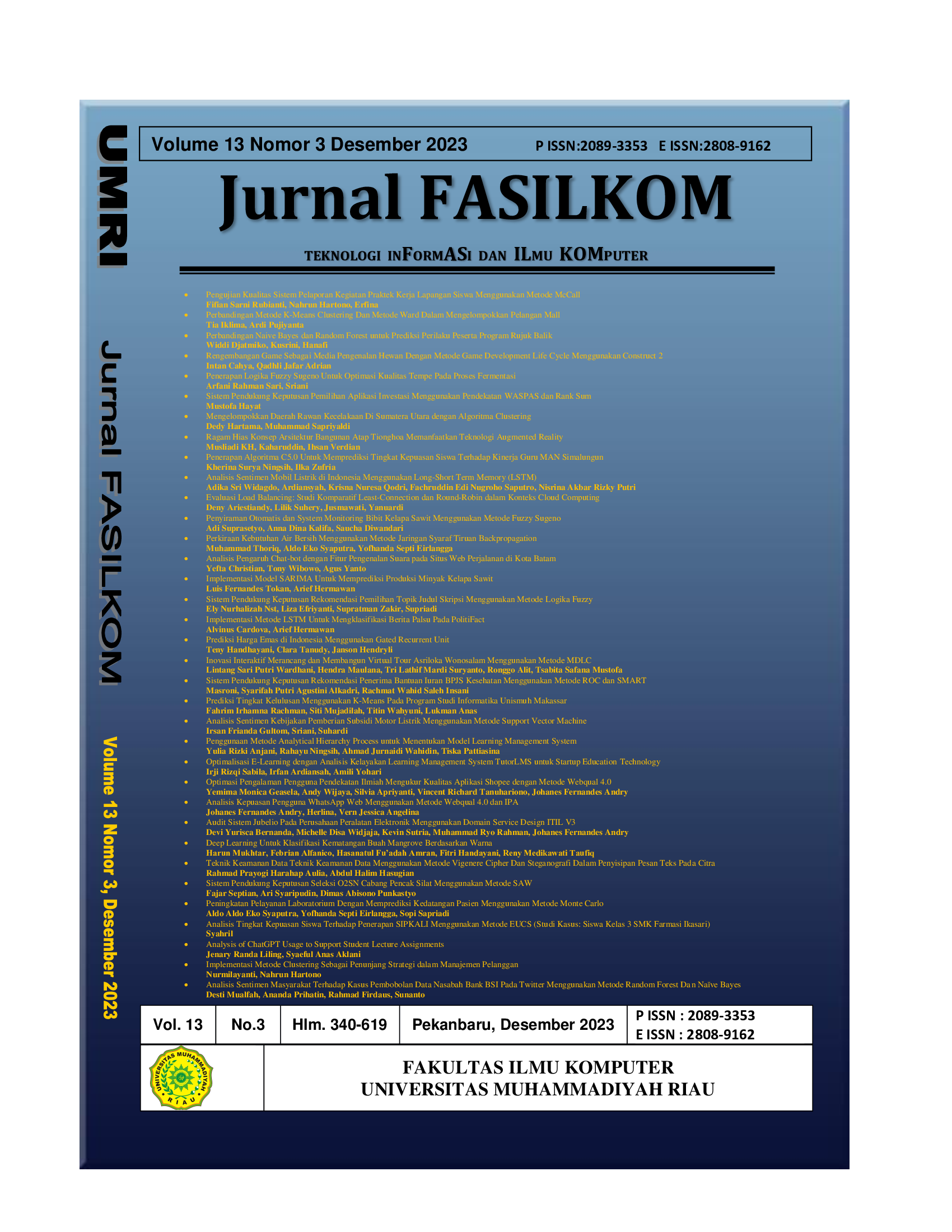Analisis Sentimen Mobil Listrik di Indonesia Menggunakan Long-Short Term Memory (LSTM)
DOI:
 https://doi.org/10.37859/jf.v13i3.6303
https://doi.org/10.37859/jf.v13i3.6303
Abstract
Vehicles using fuel oil that is converted into mechanical energy were introduced in 1891 by John W. Lambert in America. But with this, the level of air pollution caused by exhaust emissions has become a problem today, until environmentally friendly engine innovations appear. The beginning of the development of these innovations was marked by hybrid technology cars. This technology has not completely abandoned the use of oil as fuel. In general, these vehicles are known as HEV or Hybrid Electic Vehicles. Then came a car that was entirely with an electric motor drive or EV or Electric Vehicle. Although the technology is considered environmentally friendly, on the other hand it does not make all elements of society accept any changes, especially in fuel oil engines to electric motors. With these changes, there are pros and cons that are the focus of researchers by utilizing sentiment analysis which is a Natural Language Processing (NLP) scientific family to analyze what aspects make society pro or con to the emergence of environmentally friendly vehicles. Data collection in this study took from YouTube comments in the form of Indonesian text data carried out using Python programming language and Long-Short Term Memory (LSTM) as an algorithm for analyzing public opinion. The dataset was divided into training data and test data with a ratio of 67:33, The results showed that the model can be used on Indonesian text data well. Then for the process of accuracy test data 63%, then macro avg precision 62%, macro avg recall 60%, macro avg f1-score 60%, weighted avg precision 62%, weighted avg recall 63%, weighted avg f1-score 62%, roc_auc 81%. In this study, it can also be seen that the topic of discussion that often arises, namely prices in all classes. However, negative sentiment is more than other sentiment classes, one of which is due to electric car manufacturers so it is very necessary to pay attention to stakeholders regarding prices that are suitable for the Indonesian market.
Downloads
References
[2] A. M. Siregar and C. A. Siregar, “Rekayasa Saluran Gas Buang Sepeda Motor Guna Mengurangi Pencemaran Udara,” Jurnal Rekayasa Material, Manufaktur dan Energi, vol. 2, no. 2, pp. 171–179, 2019.
[3] A. R. Harfit, “Kajian Mobil Hybrid dan Kebutuhannya di Indonesia,” Jakarta: Program Pasca Sarjana Universitas Gunadarma, 2013.
[4] A. M. Simbolon and B. Rusli, “Kebijakan Kendaraan Listrik dalam Perspektif Pasar dan Infrastruktur: Studi Reviu Komparasi Bilateral Korea Selatan dan Indonesia,” Jurnal Penelitian Transportasi Darat, vol. 24, no. 2, pp. 83–91, 2022.
[5] R. Mulyadi, K. D. Artika, and M. Khalil, “Perancangan sistem kelistrikan perangkat elektronik pada mobil listrik,” ELEMEN: JURNAL TEKNIK MESIN, vol. 6, no. 1, pp. 7–12, 2019.
[6] N. F. Ananda, “Propulsi Hyper Hybrid Tesla Model Y,” 2022.
[7] V. T. P. Sidabutar, “Kajian pengembangan kendaraan listrik di Indonesia: prospek dan hambatannya,” Jurnal Paradigma Ekonomika, vol. 15, no. 1, pp. 21–38, 2020.
[8] H. Yatriendi, A. M. N. Putra, and F. A. Muchtari, “Overview: perkembangan teknologi pengisian cepat pada kendaraan listrik (teknologi dan infrastruktur),” in Seminar Nasional Riset & Inovasi Teknologi, 2022, pp. 128–137.
[9] E. Liun, “Dampak Peralihan Massal Transportasi Jalan Raya Ke Mobil Listrik.,” Jurnal Pengembangan Energi Nuklir, vol. 19, no. 2, pp. 113–122, 2018.
[10] A. Agustian and F. Nurapriani, “Analisis Sentimen, Text Mining Penerapan Analisis Sentimen Dan Naive Bayes Terhadap Opini Penggunaan Kendaraan Listrik Di Twitter,” Jurnal TIKA, vol. 7, no. 3, pp. 243–249, 2022.
[11] N. Nugroho and S. Agustina, “Analisa motor DC (Direct Current) sebagai penggerak mobil listrik,” Jurnal Mikrotiga, vol. 2, no. 1, p. 28, 2015.
[12] D. R. Alghifari, M. Edi, and L. Firmansyah, “Implementasi Bidirectional LSTM untuk Analisis Sentimen Terhadap Layanan Grab Indonesia,” Jurnal Manajemen Informatika (JAMIKA), vol. 12, no. 2, pp. 89–99, 2022.
[13] A. R. Isnain, H. Sulistiani, B. M. Hurohman, A. Nurkholis, and S. Styawati, “Analisis Perbandingan Algoritma LSTM dan Naive Bayes untuk Analisis Sentimen,” JEPIN (Jurnal Edukasi dan Penelitian Informatika), vol. 8, no. 2, pp. 299–303, 2022.
[14] A. D. Arisandi, L. Atika, E. S. Negara, and K. R. N. Wardani, “Prediksi Mata Uang Bitcoin Menggunakan LSTM Dan Sentiment Analisis Pada Sosial Media,” Jurnal Ilmiah KOMPUTASI, vol. 19, no. 4, pp. 559–566, 2020.
[15] M. Z. Rahman, Y. A. Sari, and N. Yudistira, “Analisis Sentimen Tweet COVID-19 menggunakan Word Embedding dan Metode Long Short-Term Memory (LSTM),” Jurnal Pengembangan Teknologi Informasi dan Ilmu Komputer, vol. 5, no. 11, pp. 5120–5127, 2021.
[16] A. S. Widagdo, B. S. WA, and A. Nasiri, “Analisis tingkat kepopuleran e-commerce di indonesia berdasarkan sentimen sosial media menggunakan metode naïve bayes,” Jurnal Informa: Jurnal Penelitian dan Pengabdian Masyarakat, vol. 6, no. 1, pp. 1–5, 2020.
[17] M. A. Amrustian, W. Widayat, and A. M. Wirawan, “Analisis Sentimen Evaluasi Terhadap Pengajaran Dosen di Perguruan Tinggi Menggunakan Metode LSTM,” JURNAL MEDIA INFORMATIKA BUDIDARMA, vol. 6, no. 1, pp. 535–541, 2022.
[18] E. Yuniar, D. S. Utsalinah, and D. Wahyuningsih, “Implementasi Scrapping Data Untuk Sentiment Analysis Pengguna Dompet Digital dengan Menggunakan Algoritma Machine Learning,” Jurnal Janitra Informatika dan Sistem Informasi, vol. 2, no. 1, pp. 35–42, 2022.
[19] C. Zai, “Implementasi Data Mining Sebagai Pengolahan Data,” Jurnal Portal Data, vol. 2, no. 3, 2022.
[20] F. Pramono, D. Rosiyadi, and W. Gata, “Integrasi N-gram, Information Gain, Particle Swarm Optimation di Naïve Bayes untuk Optimasi Sentimen Google Classroom,” Jurnal RESTI (Rekayasa Sistem Dan Teknologi Informasi), vol. 3, no. 3, pp. 383–388, 2019.
[21] M. A. Nurrohmat and S. N. Azhari, “Sentiment Analysis of Novel Review Using Long Short-Term Memory Method,” IJCCS (Indonesian Journal of Computing and Cybernetics Systems), vol. 13, no. 3, pp. 209–218, 2019.
[22] A. R. A. Anisa, “ANALISIS PART OF SPEECH TAGGING BAHASA INDONESIA DALAM SWAMEDIKASI DIALOG INTERACTIVE QUESTION ANSWERING MENGGUNAKAN METODE HMM,” Jurnal Teknologi Pintar, vol. 2, no. 10, 2022.
[23] A. G. Arja, “PENERAPAN SENTIMEN ANALIS MENGGUNAKAN METODE NAÏVE BAYES DAN SVM,” Jurnal Ilmu Data, vol. 2, no. 12, 2022.
[24] W. Saefudin, A. Komarudin, and R. Ilyas, “Visualisasi Kumpulan Berita Dalam Bentuk Peta Digital Dengan Metode Term Frequency-Inverse Document Frequency dan Gazetteer,” in Seminar Nasional Sains dan Teknologi Informasi (SENSASI), 2019.
[25] K. S. Nugroho, I. Akbar, and A. N. Suksmawati, “Deteksi Depresi dan Kecemasan Pengguna Twitter Menggunakan Bidirectional LSTM,” arXiv preprint arXiv:2301.04521, 2023.
[26] M. F. Rizkilloh and S. Widiyanesti, “Prediksi Harga Cryptocurrency Menggunakan Algoritma Long Short Term Memory (LSTM),” Jurnal RESTI (Rekayasa Sistem dan Teknologi Informasi), vol. 6, no. 1, pp. 25–31, 2022.
[27] A. E. Augustia, R. Taufan, Y. Alkhalifi, and W. Gata, “Analisis Sentimen Omnibus Law Pada Twitter Dengan Algoritma Klasifikasi Berbasis Particle Swarm Optimization,” Paradigma, vol. 23, no. 2, pp. 158–166, 2021.
[28] Z. Annisa and B. S. S. Ulama, “Analisis Sentimen Data Ulasan Pengguna Aplikasi ‘PeduliLindungi’ pada Google Play Store Menggunakan Metode Naïve Bayes Classifier Model Multinomial,” Jurnal Sains dan Seni ITS, vol. 11, no. 6, pp. D464–D471, 2023.
Downloads
Published
Issue
Section
License
Copyright Notice
An author who publishes in the Jurnal FASILKOM (teknologi inFormASi dan ILmu KOMputer) agrees to the following terms:
- Author retains the copyright and grants the journal the right of first publication of the work simultaneously licensed under the Creative Commons Attribution-ShareAlike 4.0 License that allows others to share the work with an acknowledgement of the work's authorship and initial publication in this journal
- Author is able to enter into separate, additional contractual arrangements for the non-exclusive distribution of the journal's published version of the work (e.g., post it to an institutional repository or publish it in a book) with the acknowledgement of its initial publication in this journal.
- Author is permitted and encouraged to post his/her work online (e.g., in institutional repositories or on their website) prior to and during the submission process, as it can lead to productive exchanges, as well as earlier and greater citation of the published work (See The Effect of Open Access).
Read more about the Creative Commons Attribution-ShareAlike 4.0 Licence here: https://creativecommons.org/licenses/by-sa/4.0/.












_(1).png)





